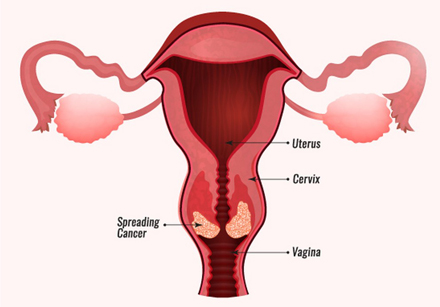Cervical Cancer
Cervical cancer is a condition that causes abnormal (cancer) cell proliferation in the cervix’s tissues. Infection with the human papillomavirus (HPV) is the leading cause of cervical cancer. Early cervical cancer normally has no symptoms, but it can be detected early with routine check-ups. Cervical cancer symptoms include vaginal bleeding and pelvic pain. For individuals seeking cervical cancer treatment in Mumbai, there are various healthcare facilities and specialized clinics that offer comprehensive care and advanced treatment options.

Treatment for Cervical Cancer?
Surgery
A laparoscopic hysterectomy is performed when the uterus and cervix are removed through a tiny incision in the abdomen using a laparoscope.
Total Hysterectomy: The uterus, including the cervix, is removed during surgery. A vaginal hysterectomy is performed when the uterus and cervix are removed through the vagina. A total abdominal hysterectomy is performed when the uterus and cervix are removed through a major incision (cut) in the abdomen.
Radical Hysterectomy: The uterus, cervix, a portion of the vagina, and a large region of ligaments and tissues surrounding these organs are all removed during a radical hysterectomy. The ovaries, fallopian tubes, or lymph nodes around the ovaries may also be removed.
Modified Radical Hysterectomy: Surgery to remove the uterus, cervix, upper portion of the vagina, as well as the ligaments and tissues that surround these organs. Lymph nodes in the vicinity may also be removed. This form of surgery does not remove as many tissues and/or organs as a radical hysterectomy.The cervix, nearby tissue and lymph nodes, and the upper part of the vagina are all removed during a radical trachelectomy. The uterus and ovaries are not removed during the procedure.
Bilateral Salpingo-Oophorectomy is a surgical procedure that removes both ovaries and fallopian tubes.
Chemotherapy is a cancer treatment that employs medications to stop the proliferation of cancer cells, either by killing them or preventing them from growing. Chemotherapy medications enter the bloodstream and can reach cancer cells throughout the body when administered orally or injected into a vein or muscle (systemic chemotherapy). The method of administration of chemotherapy is determined by the type and stage of the cancer being treated.
Radiation therapy is a type of cancer treatment that uses high-energy x-rays or other types of radiation to either kill or prevent cancer cells growth.
Uterus Cancer
Uterus cancer is a common cancer that affects the female reproductive system. The most prevalent indication of uterus cancer is abnormal vaginal bleeding.Treatment
Laparoscopic Hysterectomy (Keyhole Surgery): A laparoscope, a narrow tube with a light and camera, is used in this procedure. The surgeon inserts the laparoscope and equipment into the abdomen through 3–4 tiny cuts (belly). The uterus and other organs are removed via the vaginal canal.
Robotic-Assisted Hysterectomy is a subset of laparoscopic hysterectomy. The instruments and camera are entered through 4–5 small wounds and are operated by robotic arms guided by the surgeon, who is seated next to the operating table.
Abdominal Hysterectomy (Open Surgery or Laparotomy): The procedure is carried out through the abdomen. Typically, a cut is made from the pubic area to the belly button. After that, the uterus and other organs are removed.
Radiation Treatment: Radiation therapy is routinely used as an extra treatment following surgery for uterine cancer to lower the risk of the cancer recurrence. This is known as adjuvant therapy. If you are not well enough for a major operation due to other health issues, radiation therapy may be advised as the primary treatment in some circumstances.
Chemoradiation: High-risk endometrial cancer is frequently treated with EBRT in conjunction with chemotherapy to lessen the likelihood of the cancer returning after treatment is completed. Chemoradiation is the combination of radiation therapy and chemotherapy.
Ovarian Cancer
Ovarian cancer is a type of cancer that develops in the ovary. It causes abnormal cells to form that can invade or spread to other sections of the body. There may be no or only vague symptoms when this process begins. As the cancer grows, symptoms become more evident. Bloating, pelvic pain, abdominal swelling, constipation, and loss of appetite are some of the symptoms.
Treatment
Surgery: The majority of ovarian malignancies can be treated surgically. The extent of surgery required is usually determined by how far the cancer has gone as well as the patient’s overall health. In many situations, the condition can be treated without removing the uterus and ovaries. The major purpose of the procedure is to totally eliminate the malignancy from the body.
Chemotherapy: When cancer has spread to other places of the body, the patient must go through Chemotherapy. It is a systematic treatment in which medications are administered in such a way that they reach all sections of the body. The medications are usually injected into a vein, inserted through a small tube into the abdominal cavity, or taken orally.
Hormone Therapy: Hormone-blocking medications are used in Hormone Therapy to fight cancer. This therapy method is beneficial in the treatment of ovarian stromal tumours.
Targeted Therapy: A relatively new type of treatment, targeted therapy employs medications that directly attack cancer cells while inflicting less harm to healthy cells.
Radiation Therapy: Radiation Therapy is the use of high-energy particles or X-rays to eliminate cancer cells. Radiation Therapy, on the other hand, is used in conjunction with chemotherapy or when the patient does not react to other treatment options.
Call and book your appointment with Dr. Anushumala one of the renowned gynecologists in Kokilaben Ambani Hospital, for Cervical cancer treatment in Mumbai.
